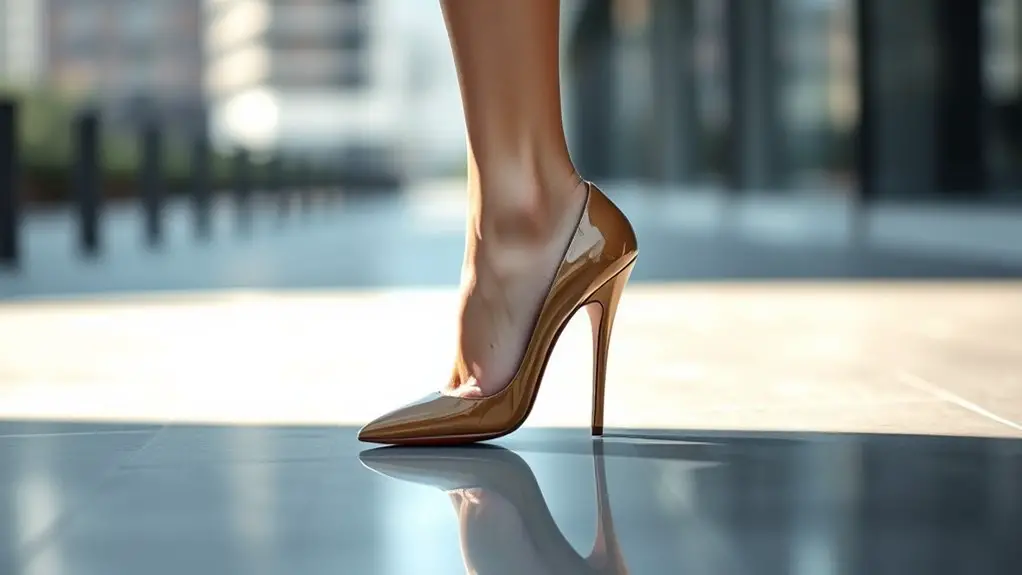Walking in heels without falling involves understanding the biomechanics of your foot and maintaining balance. Proper posture is essential, as it helps distribute weight evenly. Choosing heels with block bases and cushioned insoles enhances stability. Practicing techniques like heel-to-toe walking and single-leg stands can build your confidence and core strength. Be aware of your surroundings and foot positioning to avoid hazards. Master these concepts, and you’ll discover more strategies to enhance your heel-walking skills.
The Biomechanics of High Heels

When you wear high heels, understanding the biomechanics at play is essential for maintaining balance and stability. The heel design greatly influences how your weight is distributed across your foot. A higher heel shifts your center of gravity forward, requiring greater engagement of your ankle and foot muscles to remain upright. This alteration in weight distribution can also impact foot flexibility, as the rigid structure of the heel limits natural foot movement.
To walk effectively in heels, you’ll need to adapt your gait. Shortening your stride and rolling through your foot can help you maintain better control while traversing uneven surfaces. Additionally, the arch of the heel can affect how force is transmitted through your foot, impacting overall comfort and stability. Knowing these biomechanical principles allows you to make informed choices about heel height and design, ultimately enhancing your walking experience while minimizing the risk of falling.
Understanding Balance and Stability
Understanding balance and stability is essential for steering through the challenges of walking in high heels, especially since these factors directly influence your ability to remain upright. To enhance your balance and stability, consider incorporating the following techniques into your routine:
- Single-leg Stands: Practice standing on one leg to improve proprioception and core strength.
- Heel-to-Toe Walks: Walk in a straight line placing the heel of one foot directly in front of the toes of the other to refine your balance.
- Balance Exercises: Engage in exercises like yoga or Pilates that focus on core stability and body awareness.
- Stability Training: Use balance boards or stability balls to challenge your center of gravity and strengthen stabilizing muscles.
The Role of Posture in Heel Walking

Your posture plays an essential role in walking confidently in heels. Maintaining core stability and proper alignment of your spine and hips can greatly enhance your balance and reduce the risk of falling. By focusing on these elements, you can improve your overall heel walking technique.
Importance of Core Stability
Although many may underestimate the significance of core stability, it plays an essential role in maintaining proper posture while walking in heels. A strong core enhances your balance and control, reducing the risk of falls. To improve your core strength, consider incorporating the following stability exercises into your routine:
- Planks – Focus on holding a stable position to engage your entire core.
- Russian Twists – Strengthen obliques and improve rotational stability.
- Bird-Dogs – Enhance coordination and balance by extending opposite limbs.
- Bridges – Activate the glutes and lower back, contributing to overall stability.
Alignment of Spine and Hips
Proper alignment of the spine and hips is essential for maintaining stability when walking in heels. When your spine alignment is correct, it helps distribute weight evenly, reducing the risk of wobbling or falling. Pay attention to hip positioning; your hips should be squared and level to optimize balance.
Here’s a quick reference table to help you visualize proper alignment:
| Component | Ideal Positioning |
|---|---|
| Spine | Neutral, straight |
| Hips | Level, facing forward |
| Shoulders | Relaxed, aligned with hips |
Foot Anatomy and Its Impact on Walking
Understanding foot anatomy is fundamental for mastering the art of walking in heels, as the structure and function of the feet greatly influence balance and stability. The unique foot structure affects how pressure is distributed across your feet, which is significant when maneuvering in high heels. Here are four key components to take into account:
Mastering the art of walking in heels relies on understanding foot anatomy, crucial for balance and stability.
- Arch: The arch supports weight and affects how you distribute pressure while walking.
- Metatarsals: These bones bear the brunt of pressure when wearing heels, impacting comfort and stability.
- Toe Alignment: Proper alignment helps maintain balance and prevents excessive strain.
- Ankle Mobility: Flexibility in the ankle is essential for adjusting to the height of heels and maintaining stability.
Techniques for Building Confidence in Heels

To build confidence in heels, start with low heels before progressing to higher styles. Focus on practicing walking techniques, such as taking smaller steps and shifting your weight properly. Additionally, improving your balance and posture will enhance stability and make walking in heels more manageable.
Start With Low Heels
Starting with low heels is an effective way to build your confidence in walking in heels. By choosing low heel types, you’ll find it easier to adjust to the added height and improve your balance. Here are some strategies to get started:
- Choose heels with a height of 1-2 inches: This range provides stability while still giving you a slight lift.
- Opt for block heels: These offer a broader base, enhancing support and comfort.
- Wear cushioned insoles: This can alleviate pressure and improve comfort during wear.
- Practice on flat surfaces: Familiarize yourself with your new heels in a safe environment before venturing out.
Practice Walking Techniques
Once you’ve gained comfort with low heels, it’s time to refine your walking technique. Start by practicing heel walking, allowing your heel to touch the ground first, followed by your toes. This method promotes a smoother stride and minimizes wobbling. Incorporate balance exercises, such as standing on one foot or using a balance board, to strengthen your stabilizing muscles. These exercises enhance your overall stability, making it easier to maintain control in higher heels. Additionally, practice walking in a straight line to improve your alignment and focus. As you become more confident, gradually increase the heel height while consistently applying these techniques. Consistent practice will build your confidence and help you walk gracefully in heels without falling.
Improve Balance and Posture
While mastering the art of walking in heels, improving your balance and posture is essential for building confidence. By focusing on posture alignment and incorporating balance exercises, you can enhance your stability. Here are four effective techniques to help you:
- Heel-to-Toe Walk: Practice walking in a straight line, placing your heel directly in front of your toes with each step.
- Single-Leg Balance: Stand on one leg for 30 seconds, then switch; this strengthens your ankle stability.
- Wall Support: Use a wall for support while practicing your posture; guarantee your shoulders are back and your core is engaged.
- Strength Training: Incorporate exercises like squats and lunges to build leg and core strength, enhancing overall balance.
With consistency, you’ll walk confidently in heels!
Tips for Choosing the Right Heels
When selecting the right heels, it’s essential to take into account both comfort and style to guarantee you can wear them confidently throughout the day. Start with heel height; a lower heel can provide better stability and support, making it easier to walk without strain. For beginners, consider heels under three inches to help you adjust gradually.
Next, focus on material choice. Opt for genuine leather or high-quality synthetic options that offer flexibility and breathability. These materials conform to your foot shape, enhancing comfort during extended wear. Additionally, look for padded insoles and arch support, which can greatly improve your overall walking experience.
Lastly, pay attention to the heel shape; wider bases offer more balance than stilettos. By carefully considering heel height and material choice, you’ll ensure that your selection not only looks stylish but also supports your foot health.
Practicing Safe Heel Walking Techniques
To walk confidently in heels, mastering proper techniques is essential, as this can considerably reduce the risk of falls and discomfort. Here are some safe heel walking techniques you should practice:
- Choose Safe Surfaces: Opt for flat, stable ground to minimize slipping and instability.
- Understand Heel Types: Familiarize yourself with different heel types; block heels offer more balance than stilettos.
- Mind Your Posture: Keep your back straight and shoulders relaxed to maintain balance and distribute your weight evenly.
- Take Smaller Steps: Short, deliberate strides help you maintain control and reduce the risk of tripping.
Frequently Asked Questions
Can Wearing Heels Daily Cause Permanent Foot Damage?
Wearing heels daily can indeed impact your foot health. Long-term effects may include issues like bunions, plantar fasciitis, or nerve damage. It’s essential to balance style with comfort to minimize potential damage to your feet.
How Do Different Heel Heights Affect Walking Mechanics?
Did you know that 70% of women experience foot pain from high heels? Heel biomechanics shift your center of gravity, affecting gait analysis, with higher heels leading to altered stride and increased risk of instability.
Are There Specific Exercises to Strengthen Ankle Muscles?
To strengthen ankle muscles, focus on balance training exercises like single-leg stands and resistance band movements. These enhance ankle stability, improving your overall balance and reducing the risk of injury during activities, including wearing heels.
Do Certain Heel Styles Provide Better Support Than Others?
Imagine traversing a tightrope; certain heel styles, like platform heels and wedge shoes, offer more stability. They distribute weight better, reducing strain on ankles and enhancing balance, making your walk more confident and secure.
What Are the Best Surfaces for Practicing Walking in Heels?
For practicing walking in heels, smooth surfaces like hardwood or tile offer stability, while textured surfaces can enhance grip and balance. It’s essential to alternate between both to develop adaptability and confidence in your heel-walking skills.



